Our partner PM Elena Zubareva supervised eCommerce projects in a variety of domains: pharma, apparel, home appliances, food and beverages, art. With her support, our team develop, replatform, upgrade and redesign online stores.
What helps Elena and her team meet deadlines?
How to choose the right pricing model for the project?
How to deal with conflicts within a team?
Find out below!
When starting a project, a client and software development partner have to agree on a pricing model*. How to choose the best-fit option?
*pricing model stipulates payment obligations between the customer and supplier.
Elena: “Firstly, let me compare the two most common pricing models, their pros and cons.
Fixed price is generally suitable for the development of MVP (a product demo version that is used to test the business idea) and projects with limited budget and opportunities
Pros: fixed price, clear deadlines, predictable results.
Cons: long planning; no fixing of unpredictable flaws; impossibility to modify the project according to market changes happening during the development.
Time & Material is suitable for
– a long-term project
– a project with changing requirements
– a project with no defined scope of work.
Pros: flexibility in making changes upon client’s wish or market necessity; iterative planning; advanced quality of the final solution due to fixing unpredictable flaws and making non-planned improvements.
Cons: undefined budget and timeframe.
To make the right choice, you should evaluate a number of project characteristics. The most common are:
– budget
– project type — for example, development of an online store from scratch, migration to another eCommerce platform, theme development.
– scope — the number of tasks to be done, expected results, limitations, etc.
– estimated release date.
After the evaluation is completed, you can pick a suitable model. In my practice, Time & Material is more common.”
What are your strategies to avoid burning deadlines?
Elena: “It is necessary to pay attention both to the process organization and employees’ motivation. I keep in mind some basic principles:
– Respond in time to any signals that affect the project. Like, someone caught a cold or burned out, a conflict arose within the team, or the production stopped working
– Learn the strengths and weaknesses of each team member to distribute work accordingly
– Make sure each teammate understands the subject area and one’s tasks.
– Build workflows and select tools together with the team. This will help to improve the quality of the process as well as speed and ability to set realistic deadlines.
– Maintain a supportive atmosphere: offer real help to the employees, solve conflicts together.
– Stay positive :)
And here are some concrete tactics that help me to minimize deadline issues:
– Daily discussion of the progress with the team helps to detect deviations from the time frame at the very beginning, or even prevent them
– Retrospective is especially important for big teams (10+ people). There you share insights on what worked well during the sprint, and what can be improved. This helps to learn from mistakes and acquire a set of working methods for the future. To involve each team member I organize universal voting or provide a document stating the possible causes of the problems for anonymous filling it out.
– 1:1 meeting with the team members is a safe place where each teammate can speak out and get all necessary to stay motivated
– Planning poker helps to set realistic and convenient task completion deadlines while supporting each teammate’s involvement. In short, this technique uses cards for consensus-based estimation of project efforts by all team members.
If shifting deadlines is still inevitable, my task is to provide the client with an exhausting explanation and solid arguments on why this happened. After reaching the agreement, we update our strategy. For example, redistribute tasks.”
Apart from missing deadlines, what other challenges do you often face?
Elena: “Well, another challenge is internal conflicts.
Recently I handled one. The reason was different opinions of team members on how to solve a development task. This is the most common reason for the conflicts, by the way.
To find consensus, I give a word to both sides of the conflict: let them explain their visions, provide arguments, criticize the opponent, etc.
Then we summarized both opinions and presented them to our Development Team Lead. As a result, we found a compromise solution, and the conflict was settled.”
In what ways do your clients get informed on the project’s progress? What info do you provide the clients with?
Elena: “A form of project tracking is defined by the client’s demands and project peculiarities. Most often, we use the following ways or their combinations:
– Daily reports ― they state which tasks were completed, and which are going to be proceeded with the next day
– Weekly meetings ― here we discuss what was done and what is planned, and synchronize tasks with the client’s team
– Gantt chart ― a visualized schedule of the project. It’s a bar chart where tasks, their sequence, and time frame of their completion are highlighted.
Upon the client’s wish, we apply project management tools. For example, Asana ― it’s free, easy to use, and has all essential functions. Or Jira ― it’s paid but offers advanced functionality.”
Being a Project Manager may be challenging. You need to address clients’ and team’s issues, settle conflicts, coordinate tasks, make decisions, and all this in a mess and tense sometimes. Have you experienced burnout?
Elena: “Oh, that’s a good question.
There was a time I didn’t switch off the job tasks in my free time. For example, I used to schedule calls with clients late in the evening. As I had no proper rest, my resources wore thin, and I felt very exhausted.
What helped me to recover? Drawing a line between work and free time. Now I perform job functions during working hours only while concentrating on off-work duties, relaxing, and entertaining after work. Both I and my job feel fine :)”
Elena, thanks a lot for such an informative talk!
Elena: “You’re welcome, thank you!”






